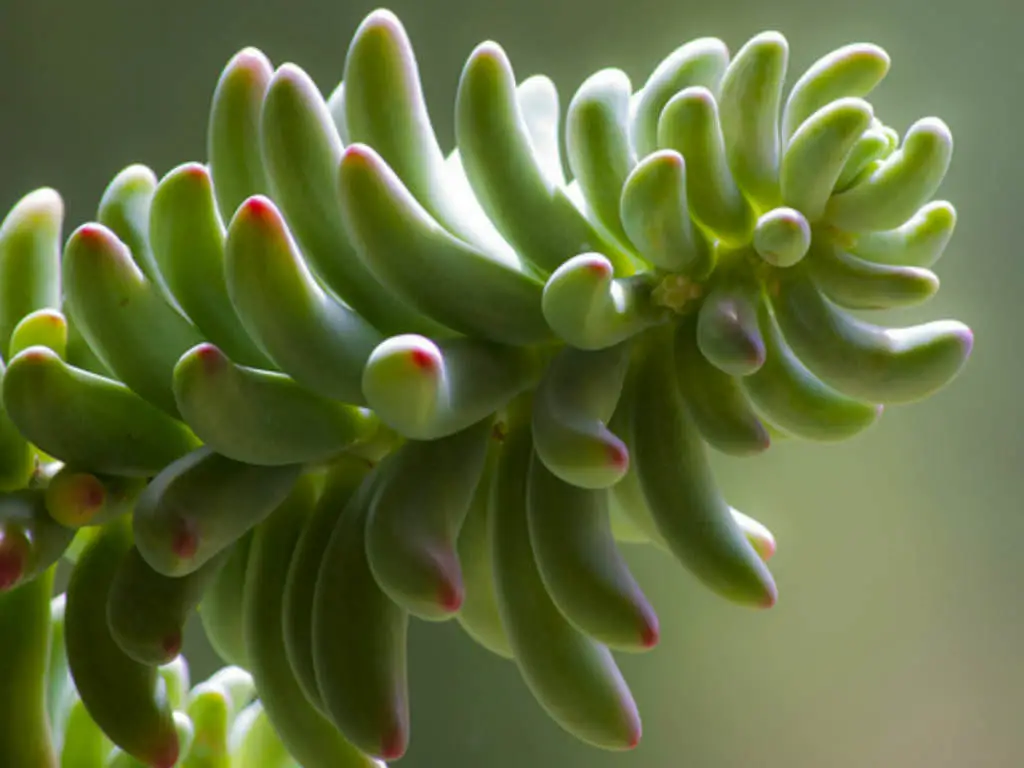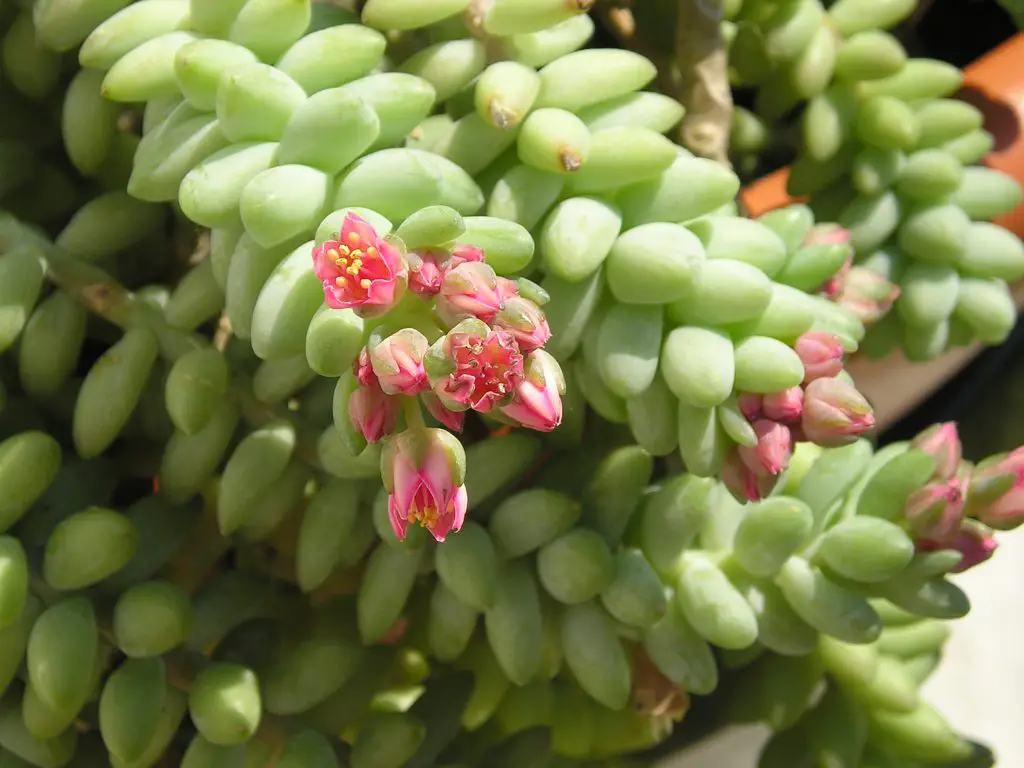The scientific name of the jelly bean is Sedum Rubrotinctum. This is a cute-looking plant because of its jelly bean-like leaves. This is a versatile plant that can easily be grown outdoors as well as indoors.
You can even grow this stunning and distinctive plant in a terrarium. If you love to grow succulents then these plants must fit in your collection. Full sun and drought are perfect for jelly bean plants so you should grow them in summer.
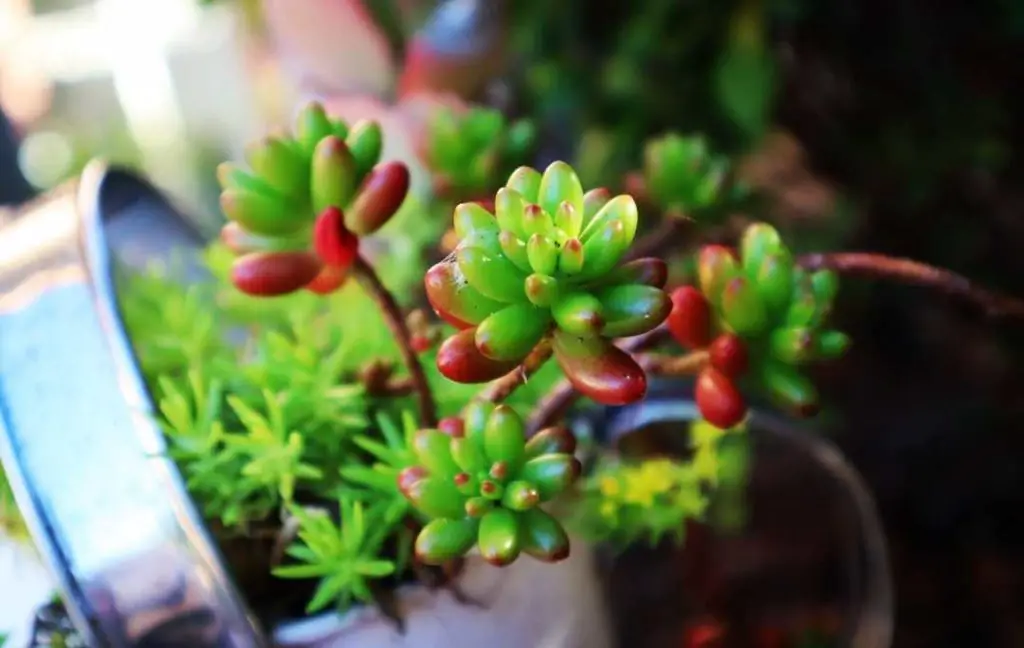
Always plant it after the danger of frost as it can’t tolerate frost. Because of its low maintenance, it is a perfect choice for beginners.
In this article, we are going to discuss with you some types of jelly bean succulents. You can choose one according to your choice.
1- GREEN JELLY BEAN – SEDUM RUBROTINCTUM
This is an evergreen perennial succulent plant. Mostly it has a brilliant shade of red on its leaves but if it does not receive light then the leaves will turn green.
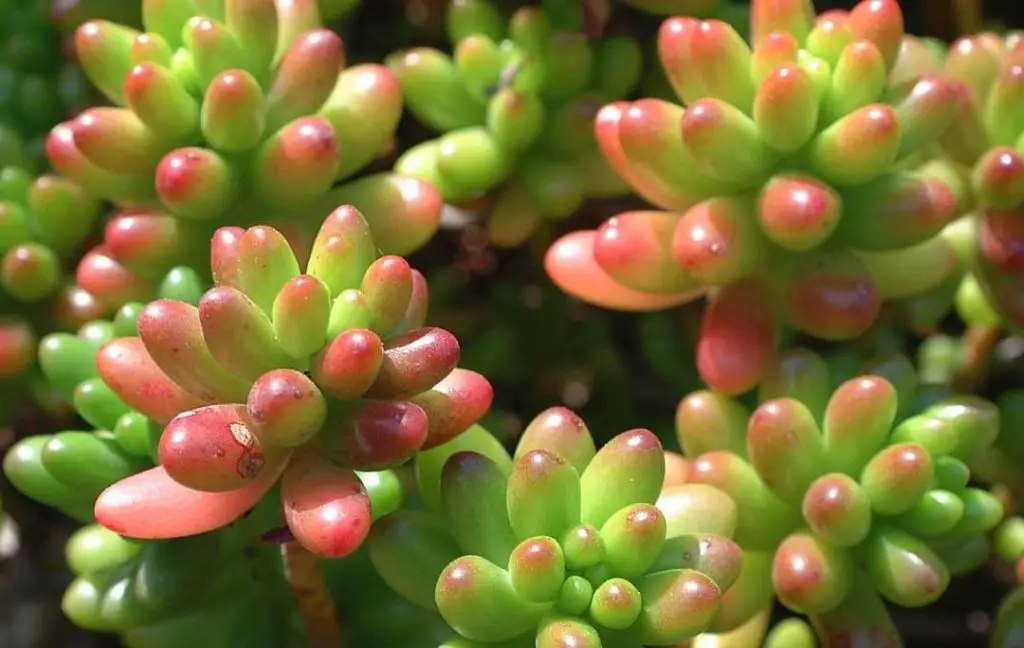
SOIL
Well-drained soil is ideal for growing succulent plants because root rot can damage your plant. It is better to buy a healthy and high-quality soil mix from any local store or you can make your own mix with cactus mix and perlite.
LIGHT
For colorful leaves, you should place your pot or container in a bright sunny location. 6 hours of sunlight is enough for growing green jelly beans. On hot days, you should move your jelly bean plants to a shady place so the plant will be prevented from being damaged.
TEMPERATURE
A very cold winter is not perfect for growing green jelly bean plants. If you are living in such an area where the temperature is always below freezing point then indoor planting is perfect.
WATER
The frequency of the water depends upon the climate in which you are living. On hot days your plants need more water because of the heat of the sun.
In fall or spring, the temperature is low so you can reduce the amount of water according to the requirement of your plant. In the winter your green jelly bean succulent plants need water every 2 to 3 weeks.
PROPAGATION
You can easily propagate green jelly beans without facing any trouble. The fastest way of propagation is by cutting with the help of a sharp scissor cutting off a stem and placing it on the surface of the soil.
Soon you will be seen the tiny young root start emerging and your cutting will turn into a new plant
2- PINK JELLY BEANS – AURORA
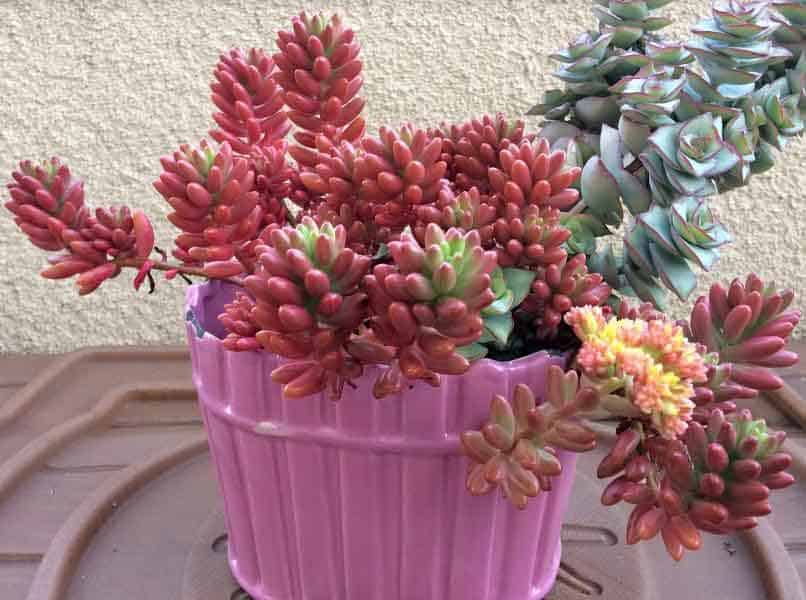
The extraordinary color of this type of jelly bean plant makes it special. The leaves of the Aurora jelly bean plants have exquisite color combinations such as pink, lime green, and cream.
This type of jelly bean is an exceptional succulent plant that can easily start in a small pot. You can spread it on the ground, in pots, in hanging baskets, and in containers. For the healthy growth of the Aurora jelly bean plant. You should be careful about the following factors.
SOIL
Well-drained and moist soil is perfect for growing Auroras. But make sure your soil should not remain wet for a long time because it will cause root rot and many fungal diseases.
If you add potting mix and perlite then it will improve the drainage quality of the soil. If you are growing jelly bean plants in a pot or container then it is better to use a perfect combination of the cactus mix, perlite, and sand.
LIGHT
Bright sunlight is needed, not full sun for the growth of Aurora Jelly Bean plants. It is better to choose a location where your plants can receive partial Sun or filtered light.
This plant can’t tolerate intense heat due to the full sun because its leaves can burn so you should be careful.
TEMPERATURE
The ideal outdoor night temperature for pink jelly bean succulent is 50 to 55 Farhenheit or 10 to 13 degrees Centigrade. The perfect indoor night temperature should be 60 to 65 degrees Fahrenheit or 15 to 18 degrees Centigrade. Under suitable temperatures this plant produces flowers.
WATER
The frequency of water for Pink jelly beans depends upon the climate in which you are living. If you are living in a dry and hot climate then your plants need more water.
Although this plant can tolerate drought. Generally, this plant needs water every 7 to 10 days on hot days. When the weather cools down you can water every 10 to 14 days.
FERTILIZER
When plants receive essential nutrients and organic materials then they thrive well. For producing beautiful flowers your plants need proper feeding. It is better to provide them with all the required nutrients in the production of flowers.
It is better to apply fertilizer during the flowering season. During spring and summer, apply fertilizer every 2 weeks. Diluted fertilizer or fertilizer formulated for succulent plants is perfect for Aurora.
PROPAGATION
Just like any succulent plant you can easily propagate pink jelly beans by leaf or stem cuttings. In any case, whether you choose stem or leaf you will be successful at it in the propagation of aurora.
Most people prefer stem propagation because it is fast and easy. You have to wait for a long time for root growth if you choose leaf propagation.
3- SEDUM LUCIDUM GIANT JELLY BEANS SUCCULENT
The glossy green leaves of freedom lucidum have red edges. Because of its leaves, it is called a giant jelly bean succulent plant. You can see white flowers when spring comes.
This plant can easily tolerate drought. You must use well-drained soil for growing it. If you are growing a giant jelly bean plant in a pot or container then you can use two parts of potting soil, two parts of peat moss, and one part of perlite.
This plant needs less water because it belongs to the succulent family. The maximum height of this plant is about 18 inches or 45 cm.
LIGHT
The lighting requirement of this plant is from full Sun to light shade. Giant jelly bean plants should receive 2 to 4 hours of sunlight in the afternoon. If you are growing it indoors, make sure you place your pot near the south-facing window.
TEMPERATURE
The perfect temperature for summer for growing this plant is between 65 °F to 75 °F or 18 °C to 25 °C. On cold days, a joint jelly Bean plant needs a temperature no lower than 50 degrees Fahrenheit to 55 degrees Fahrenheit or 12.7 degrees centigrade. This summer-loving plant can’t tolerate freezing temperatures.
WATER
When spring comes then you should water this plant more. It is better to check the soil if you feel it is dry then it is time to water your plants. When winter comes you should reduce the frequency of water.
FERTILIZER
Diluted liquid fertilizer or slow-releasing nitrogen-based fertilizer is best for giant jelly bean plants. The perfect time of applying fertilizer is in spring and summer.
PROPAGATION
You should not worry about the propagation of this plant because it can easily propagate by leaf or stem cuttings. Simply go and cut a stem from a healthy plant.
Now push it into the ground or container that you prepared. Soon you will see tiny roots start emerging from the stem. If you are using leaves for propagation then simply dry them and place them on the surface of the soil. Keep the soil moist so the plant starts its growth.
Keep Reading:
- Easy Vegetables To Grow For Kids And Beginners
- How To Use Epsom Salt In Your Garden?
- 15 Dwarf Fruit Trees For Container Garden
4- BLUE JELLY BEANS – MANY FINGERS – SEDUM PACHYPHYLLUM
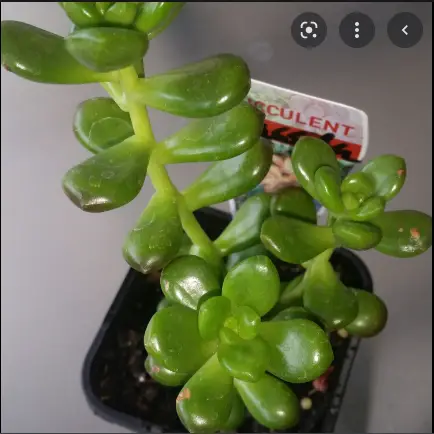
This is a popular jelly bean succulent plant because it has finger-shaped leaves. Besides finger-shaped leaves, it has a woody branch stem. The tips of the leaves are red and look fabulous.
If you are a beginner then you can grow it very easily in your garden or as an indoor plant. This plant can survive with little attention. In case you don’t have time to look after your plants but you are a plant lover then you must choose these stunning and attractive blue jelly beans plants because they can tolerate drought conditions.
In case, due to your busy routine, you forget to water your jelly bean plants then you should not worry because they can easily survive without water for a few days. This plant can reach a height of 30 cm. This plant continuously spreads itself by rooting stems.
SOIL
Blue jelly beans easily adjust in any type of soil but avoid using poor drainage such type of soil that has poor drainage. Well-aerated soil and well-drained soil are suggested.
You can also buy cactus soil because it is the perfect medium for growing blue jelly beans. You can also make your soil by mixing sand, bark, and perlite.
LIGHT
3 to 4 hours of light is enough for jellybean plants. If you are growing this plant indoors then you should place your pot or container near a south-facing window. If you place it near a north-facing window then it will not encourage healthier growth of the plant.
TEMPERATURE
In winter, the perfect temperature is between 50 to 55 degrees Fahrenheit or 10 to 12 degrees Centigrade. The perfect summer temperature is between 65 to 75 degrees Fahrenheit or 18 to 23 degrees centigrade.
Sedum pachyphyllum likes to grow in hot climates. If you are living in a cold area then it is better not to keep this plant outside especially when it is freezing.
WATER
You can maintain the frequency of water according to the weather. In spring or summer, your plants need more water than in winter. The perfect time for watering your plant is when the soil is dry. Make sure you are using well-drained soil so it will not become soggy to damage your plant.
FERTILIZER
Spring or summer is a perfect time for applying fertilizer. Sedum pachyphyllum needs feed once a month. When you add fertilizer then it will fulfill the nutrient requirements of your plant. It is better to use diluted balanced fertilizer for better results.
PROPAGATION
You can use blue jelly bean cuttings for their propagation. You must cut off the leaves from the stem. Now is the time to let them dry for planting. When the leaves are completely dry then you can place them on the surface of the soil of your pot or container.
Keep the soil moist to encourage the growth of roots. Avoid over-watering because it will not help in the process of root development.
5- SEDUM MORGANIANUM OR DONKEY’S TAIL
This is a hanging plant that needs little maintenance and is drought tolerant. As it is a coolant plant and it likes to grow in hot and dry climates. This is a hardy succulent plant that can adjust to any type of soil with little water.
SOIL
The soil must be rich, loose, and well-drained. You can also use the cactus potting mix because it has all the essential nutrients that are necessary for the growth of a donkey’s tail.
You can also make your soil mix for sedum morganianum. For this purpose, you need two parts of sharp sand, one part perlite or vermiculite, one part pumice, and one part of the compost. All these ingredients fulfil all the requirements of the donkey’s tail plant.
LIGHT
Light plays an important role in the growth of any plant. 5 to 6 hours of direct light is enough for a donkey’s tail. If you are growing this plant indoors and you can’t arrange direct sunlight for them then you can use artificial light for this purpose. For indoor planting, they need more water.
TEMPERATURE
The perfect and ideal temperature for growing a donkey’s tail is 65 to 75 degrees Fahrenheit. If the outside temperature is lower than 40 degrees Fahrenheit then you should bring your pot or container inside otherwise the frost can damage your plants.
WATER
Sedum morganianum doesn’t like wet feet so avoid over watering because it will result in root rot and many fungal diseases. It is better to carefully examine the soil if it feels dry than water your plant. Keep the topsoil moist by watering. On hot days this plant needs more water than on cold days.
FERTILIZER
To make your soil richer you can apply fertilizer once a month during the growing season. It is better to use water-soluble balanced fertilizer for better results.
When fall comes, you should stop this activity or reduce feeding. Overfeeding can burn the leaves of the plant so be careful.
PROPAGATION
You can easily propagate donkey’s tail or jelly bean plants by simply cutting off leaves from healthier plants. For cutting the leaves you need a clean scissor. Now place them on our potting soil.
Keep the soil moist for the development of roots. Soon you will see the roots sprout and leaves start turning into new plants. In this way, you can use the leaves of your old plants for the propagation of this outstanding and ornamental plant.

